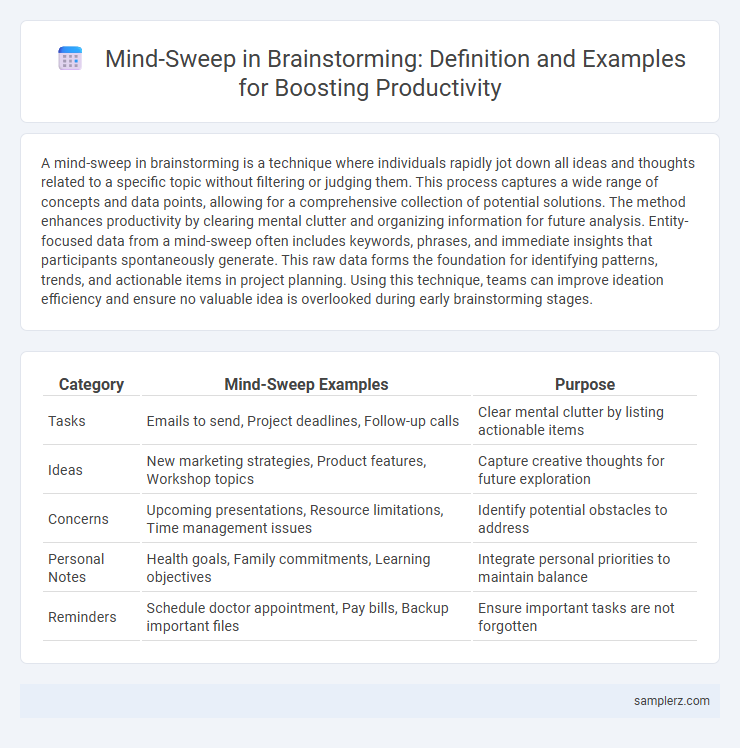A mind-sweep in brainstorming is a technique where individuals rapidly jot down all ideas and thoughts related to a specific topic without filtering or judging them. This process captures a wide range of concepts and data points, allowing for a comprehensive collection of potential solutions. The method enhances productivity by clearing mental clutter and organizing information for future analysis. Entity-focused data from a mind-sweep often includes keywords, phrases, and immediate insights that participants spontaneously generate. This raw data forms the foundation for identifying patterns, trends, and actionable items in project planning. Using this technique, teams can improve ideation efficiency and ensure no valuable idea is overlooked during early brainstorming stages.
Table of Comparison
| Category | Mind-Sweep Examples | Purpose |
|---|---|---|
| Tasks | Emails to send, Project deadlines, Follow-up calls | Clear mental clutter by listing actionable items |
| Ideas | New marketing strategies, Product features, Workshop topics | Capture creative thoughts for future exploration |
| Concerns | Upcoming presentations, Resource limitations, Time management issues | Identify potential obstacles to address |
| Personal Notes | Health goals, Family commitments, Learning objectives | Integrate personal priorities to maintain balance |
| Reminders | Schedule doctor appointment, Pay bills, Backup important files | Ensure important tasks are not forgotten |
Introduction to Mind-Sweep in Brainstorming
Mind-sweep in brainstorming involves capturing every idea that comes to mind without filtering or judgment, allowing for an unstructured flow of thoughts. This technique enhances productivity by clearing mental clutter and enabling creative insights to surface more easily. Using a mind-sweep ensures all potential solutions and ideas are documented, fostering a comprehensive exploration of the problem at hand.
Key Benefits of Mind-Sweep for Productivity
Mind-sweep enhances productivity by clearing mental clutter, allowing individuals to capture all tasks and ideas in one place for better organization. This process reduces stress and prevents important thoughts from being forgotten, improving task prioritization and time management. By externalizing cognitive load, mind-sweep boosts focus and efficiency during subsequent work sessions.
How to Prepare for a Mind-Sweep Session
Gather all relevant materials such as notebooks, digital devices, and previous brainstorming notes to centralize your ideas. Choose a quiet, distraction-free environment that fosters concentration and allows free thinking. Set a clear time limit, typically 15-30 minutes, to maintain focus and encourage rapid idea capture during the mind-sweep session.
Step-by-Step Mind-Sweep Process
The step-by-step mind-sweep process in brainstorming begins by capturing every thought and idea without judgment, ensuring no valuable insight is overlooked. Next, these ideas are categorized and organized into relevant themes or action items to enhance clarity and focus. Finally, prioritizing tasks based on urgency and impact empowers efficient execution and boosts overall productivity.
Real-World Mind-Sweep Examples
Conducting a mind-sweep during brainstorming involves rapidly jotting down all thoughts, tasks, and ideas without filtering to clear mental clutter. For instance, a product manager might list current project challenges, feature requests, and upcoming deadlines to prioritize effectively. This real-world technique boosts productivity by transforming scattered thoughts into organized action items, facilitating clearer focus and decision-making.
Tools and Techniques for Effective Mind-Sweep
Effective mind-sweep techniques include using digital tools like Notion, Evernote, and Microsoft OneNote for seamless capture and organization of ideas. Utilizing voice-to-text apps enhances speed and reduces friction during brainstorming, facilitating comprehensive idea collection. Structured methods such as bullet journaling and the Pomodoro technique help maintain focus and prioritize tasks within the mind-sweep process.
Overcoming Common Mind-Sweep Challenges
Mind-sweep techniques often face challenges such as mental clutter, incomplete listing of ideas, and difficulty prioritizing tasks. Overcoming these obstacles involves structured categorization, setting clear time limits, and using digital tools like note-taking apps to capture every thought. Regular practice of mind-sweeps enhances focus, reduces stress, and ensures no valuable idea is overlooked during brainstorming sessions.
Integrating Mind-Sweep into Daily Workflow
Integrating mind-sweep techniques into daily workflow enhances productivity by systematically capturing all thoughts, tasks, and ideas, preventing cognitive overload. Scheduling regular mind-sweep sessions during breaks or at the start of the day ensures continuous mental clarity and prioritization. This practice supports effective task management and streamlines brainstorming by transforming scattered ideas into actionable plans.
Mind-Sweep Best Practices for Teams
Mind-sweep best practices for teams involve capturing every idea without judgment to maximize creativity and prevent cognitive overload. Utilize collaborative tools like digital whiteboards or shared documents to ensure all contributions are visible and organized. Regularly schedule mind-sweep sessions at the start of projects to align team focus and identify actionable priorities quickly.
Evaluating Results After a Mind-Sweep Session
Evaluating results after a mind-sweep session involves categorizing captured ideas by relevance and feasibility to prioritize actionable tasks. Reviewing each entry for alignment with project goals enhances decision-making and prevents overlooking critical insights. This systematic analysis transforms raw input into structured plans, boosting overall productivity.

example of mind-sweep in brainstorming Infographic
 samplerz.com
samplerz.com